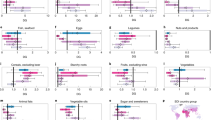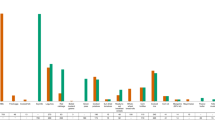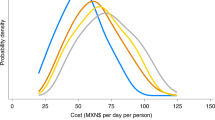Abstract
Background/objectives
It has not been reported that previously how much food New Zealand (NZ), population 4.9 million (M), exports and imports in terms of how many people this food would feed if the food-based dietary guidelines (FBDG) were followed. In New Zealand, 40% of adults and 20% of children live in a household with severe to moderate food insecurity.
Methods
Official data for foods and beverages exported and imported between 2016 and 2018 was obtained from Statistics New Zealand. Harmonised food classifications were matched to either a food group or as discretionary foods or ingredients. Standard serving sizes in grams and number of servings/day from each food group viz; vegetables, 5 servings/day; fruit, 2 servings/day; grains 6 servings/day; meat and protein foods 2.5 servings/day: and dairy 2.5 servings/day were used to determine how many people would be fed each year with the food traded. Together these servings should meet a daily energy intake in the order of 8 MJ. The trade of discretionary foods and ingredients, alcoholic beverages, butter and sugar was also examined.
Results
According to the guidelines the quantity of food exported each year by NZ had enough numbers of servings to feed 39 M dairy, 11.5 M meat, seafood and other protein, 2 M vegetables and 10 M fruit day/year. Imports were dominated by grains, enough to feed 9 M six servings a day/year. Total food energy exported and imported was enough to meet the energy requirements for 20 M (30% from butter) and 10 M (27% from sugar), respectively.
Conclusions
The high prevalence of food insecurity and obesity in NZ could be partially attributed to the disconnect between the quantity, nutritional quality and diversity of foods imported and exported.
This is a preview of subscription content, access via your institution
Access options
Subscribe to this journal
Receive 12 print issues and online access
$259.00 per year
only $21.58 per issue
Buy this article
- Purchase on SpringerLink
- Instant access to full article PDF
Prices may be subject to local taxes which are calculated during checkout


Similar content being viewed by others
References
Statistics New Zealand. Agricultural and horticultural land use. 2016. http://archive.stats.govt.nz/browse_for_stats/environment/environmental-reporting-series/environmental-indicators/Home/Land/land-use.aspx. Accessed 1 Apr 2019.
Proudfoot I. KPMG Agribusiness Agenda KPMG: Auckland; 2017.
University of Otago, Ministry of Health. A focus on nutrition key findings of the 2008/09 New Zealand adult nutrition survey. Wellington: Ministry of Health; 2011.
Ministry of Health. Household food insecurity among children in New Zealand. Wellington: Ministry of Health; 2019.
Statistics New Zealand. Child poverty statistics: Year ended June 2018. 2019. https://www.stats.govt.nz/information-releases/child-poverty-statistics-year-ended-june-2018. Accessed 30 May 2019.
Ministry of Health. New Zealand Health Survey 2017, 2018. 2019. https://minhealthnz.shinyapps.io/nz-health-survey-2017-18-annual-data-explorer. Accessed 30 May 2019.
Ministry of Health. New Zealand Health Survey 2018/19. 2019. https://minhealthnz.shinyapps.io/nz-health-survey-2017-18-annual-data-explorer. Accessed 19 Nov 2019.
New Zealand Horticulture, Plant and Food Research. Fresh facts. 2018. https://www.freshfacts.co.nz/files/freshfacts-2018.pdf. Accessed July 2019.
Plant & Food Research. New Zealand horticulture reaches new height at $8.8 billion. 2018. https://plantandfood.co.nz/page/news/media-release/story/new-zealand-horticulture-reaches-new-height/. Accessed 17 Nov 2019.
Rush E. Wicked problems: the challenge of food safety versus food security-working towards the SDG goals? Eur J Clin Nutr. 2019;73:1091–4.
Statistics New Zealand. What we do. 2019. https://www.stats.govt.nz/about-us/what-we-do/. Accessed 29 May 2019.
New Zealand Ministry of Health. Eating and activity guidelines. 2019. https://www.health.govt.nz/our-work/eating-and-activity-guidelines. Accessed 1 Apr 2019.
National Health and Medical Research Council. How much do we need each day. 2015. https://www.eatforhealth.gov.au/food-essentials/how-much-do-we-need-each-day/recommended-number-serves-adults. Accessed 1 Apr 2019.
Statistics New Zealand. New Zealand Harmonised System Classification V2017.5.0. 2019. http://aria.stats.govt.nz/aria/#ClassificationView:uri=http://stats.govt.nz/cms/ClassificationVersion/aw7C9EFuHBXYCy0H. Accessed 29 May 2019.
Ministry of Health (New Zealand), New Zealand Institute for Plant and Food Research Limited. New Zealand Food Composition Database: Food Files Data. 2019. http://www.foodcomposition.co.nz/. Accessed 19 Nov 2019.
Health Promotion Agency. What’s a standard drink? 2019. https://www.alcohol.org.nz/help-advice/standard-drinks/whats-a-standard-drink. Accessed 29 May 2019.
Brown A. Understanding food: principles and preparation, 4th ed. Belmont, CA: Wadsworth Cengage; 2011.
Rush E, Puniani N, Snowling N, Paterson J. Food security, selection, and healthy eating in a Pacific Community in Auckland New Zealand. Asia Pac J Clin Nutr. 2007;16:448–54.
Statistics New Zealand. Population Clock. 2019. http://archive.stats.govt.nz/tools_and_services/population_clock.aspx Accessed 1 Apr 2019.
National Health and Medical Research Council (Australia, New Zealand) MoHN. Nutrient reference values for Australia and New Zealand: included recommended dietary intakes. 2019. https://www.nrv.gov.au/. Accessed 16 Apr 2019.
Reynolds A, Mann J, Cummings J, Winter N, Mete E, Te Morenga L. Carbohydrate quality and human health: a series of systematic reviews and meta-analyses. Lancet. 2019;393:434–45.
Hall C, Dawson T, Macdiarmid J, Matthews R, Smith P. The impact of population growth and climate change on food security in Africa: looking ahead to 2050. Int J Agric Sustain. 2017;15:124–35.
Rizvi S, Pagnutti C, Fraser E, Bauch CT, Anand M. Global land use implications of dietary trends. PLoS ONE. 2018;13:e0200781.
Luiten CM, Steenhuis IH, Eyles H, Ni Mhurchu C, Waterlander WE. Ultra-processed foods have the worst nutrient profile, yet they are the most available packaged products in a sample of New Zealand supermarkets. Public Health Nutr. 2016;19:530–8.
Willett W, Rockstrom J, Loken B, Springmann M, Lang T, Vermeulen S, et al. Food in the Anthropocene: the EAT-Lancet Commission on healthy diets from sustainable food systems. Lancet. 2019;393:447–92.
The Institute for Health Metrics and Evaluation (IHME). New Zealand. 2019. http://www.healthdata.org/new-zealand. Accessed 29 May 2019.
Benziger CP, Roth GA, Moran AE. The global burden of disease study and the preventable burden of NCD. Glob Heart. 2016;11:393–7.
Alexandratos N. The Mediterranean diet in a world context. Public Health Nutr. 2006;9:111–7.
Lock K, Smith RD, Dangour AD, Keogh-Brown M, Pigatto G, Hawkes C, et al. Health, agricultural, and economic effects of adoption of healthy diet recommendations. Lancet. 2010;376:1699–709.
Jalava M, Guillaume JH, Kummu M, Porkka M, Siebert S, Varis O. Diet change and food loss reduction: What is their combined impact on global water use and scarcity? Earth’s Future. 2016;4:62–78.
Mackay S, Buch T, Vandevijvere S, Goodwin R, Korohina E, Funaki-Tahifote M, et al. Cost and affordability of diets modelled on current eating patterns and on dietary guidelines, for New Zealand total population, Maori and Pacific households. Int J Environ Res Public Health. 2018;15:1255.
Signal LN, Walton MD, Ni Mhurchu C, Maddison R, Bowers SG, Carter KN, et al. Tackling ‘wicked’ health promotion problems: a New Zealand case study. Health Promot Int. 2013;28:84–94.
Goodwin RM. Feeding sugar syrup to honey bee colonies to improve pollination: a review. Bee World. 1997;78:56–62.
Ministry of Primary Industries. 2016 Apiculture monitoring programme. Wellington, New Zealand: Ministry of Primary Industries; 2017.
Airborne Honey Guardians. New Zealand beekeeping statistics. 2019. https://www.airborne.co.nz/statistics/new-zealand.shtml. Accessed 29 May 2019.
Author information
Authors and Affiliations
Corresponding author
Ethics declarations
Conflict of interest
The authors declare that they have no conflict of interest.
Additional information
Publisher’s note Springer Nature remains neutral with regard to jurisdictional claims in published maps and institutional affiliations.
Rights and permissions
About this article
Cite this article
Rush, E., Obolonkin, V. Food exports and imports of New Zealand in relation to the food-based dietary guidelines. Eur J Clin Nutr 74, 307–313 (2020). https://doi.org/10.1038/s41430-019-0557-z
Received:
Revised:
Accepted:
Published:
Issue Date:
DOI: https://doi.org/10.1038/s41430-019-0557-z



